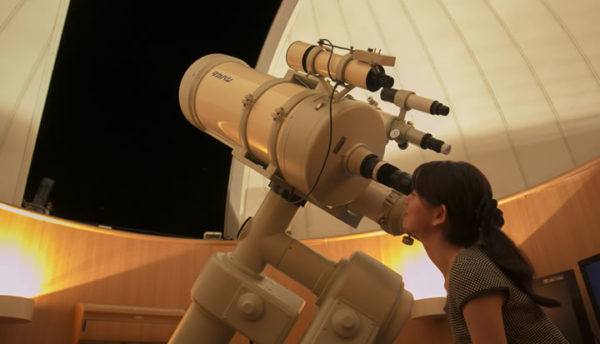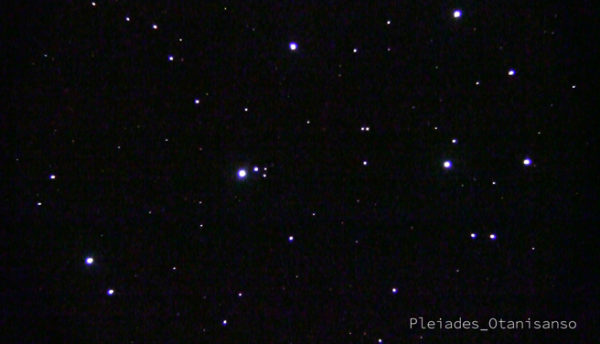- Astronomical Observatory
- 2019/06/18
【June in the Observatory】Come observe Jupiter, the planet that could have become the sun!
The sun, earth, and Jupiter will align! June is the perfect chance to observe Jupiter as it approaches the earth.
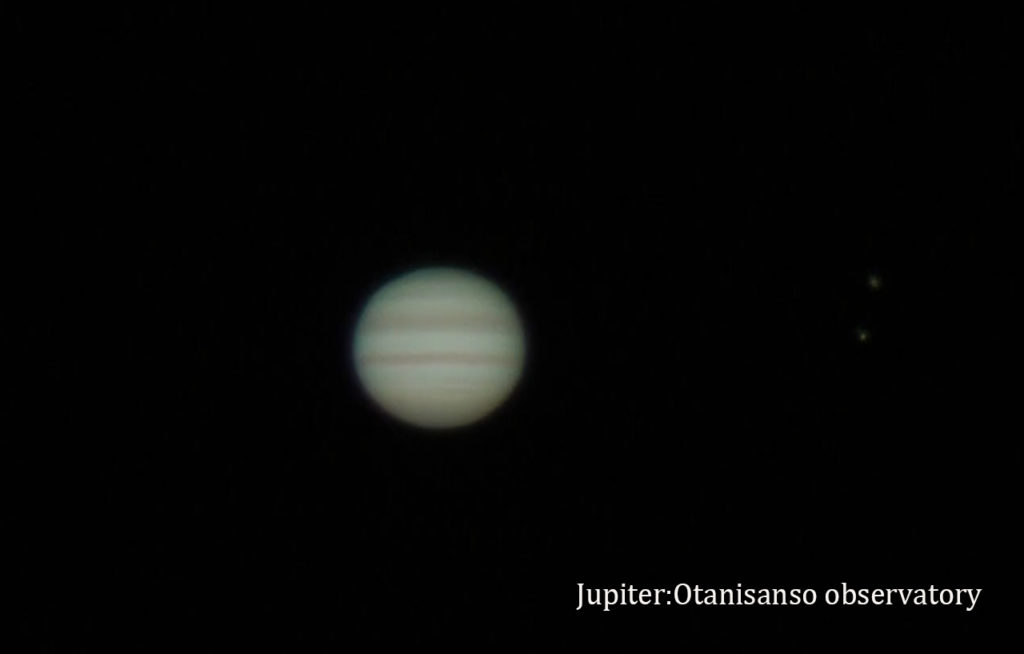
June offers a great opportunity to observe Jupiter, as we approach its alignment “in opposition” to the sun, on the opposite side of the earth.
Greetings from the Otani Sanso Astronomical Observatory Dome.Today we’ll be discussing Nagato’s night skies in June, 2019. During May, visitors will be able to get a good view of Jupiter. On June 11 (Tue), Jupiter and the sun will be in alignment, or “opposition.” Later, on June 16 (Sun), the moon and Jupiter will draw very close. There will be a full moon on June 17 (Mon), so you may be able to view the moon and Jupiter together. Additionally, beginning in late June, Saturn will begin to be visible around 9 p.m. Star-gazing in June will bring us extremely interesting skies. June is the rainy season in Japan, but please come by to take a look at the night skies. (Image: Jupiter and its moons, as photographed from the Astronomical Observatory Dome at Otani Sanso)
What is “opposition”?
The planets of the solar system are said to be in opposition when seen from the earth, in the instant when one of them is exactly opposite the sun on the other side of the earth, forming a straight line. The planets revolving around the sun are all located in different positions, but when they are “in opposition,” they form a straight line with the earth in the center, and therefore are at their closest. On June 11 (Tue), Jupiter will be in opposition with the constellation Ophiuchus (such that the sun, earth, and Jupiter will align), meaning that we will be able to see it quite early in the morning.Stellar Objects Expected to be Visible in June
- June 3 (Mon) …New Moon
- June 10 (Mon) …Waxing Moon
- June 11 (Tue) …Jupiter in opposition with the constellation Ophiuchus
- June 16 (Sun) …Moon and Jupiter will be very close
- June 17 (Mon) …Full Moon
- June 22 (Sat) …Summer Solstice
- June 25 (Tue) …Waning Moon
- Late June …Saturn will be visible around 9 p.m.
Legends related to the stars of June: Jupiter, the planet who could not become the sun
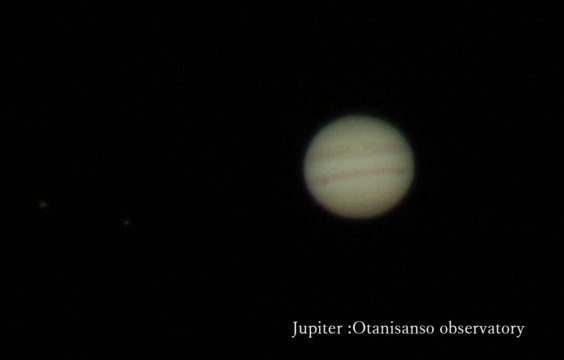
Jupiter might once have become the sun
Jupiter is a planet said to have had potential to become our sun. In fact, Jupiter and the sun are made up of very similar material (Jupiter: 90% hydrogen and 10% helium). So why was it that Jupiter did not become the sun? A great difference between the two bodies is whether or not they emit light. The sun shines because it releases energy in the form of heat and light as a result of the result fusion occuring within the star. Jupiter, however, merely reflects the sun’s light back in much the same way the moon does. In order for Jupiter to emit its own light, nuclear fusion would have to occur within the planet, but Jupiter lacks the mass to make this occur. Jupiter has 318 times the mass of earth, but in order to match the mass of the sun, Jupiter would still require another 80 times of this mass. Mass is one of the greatest differences between Jupiter and the sun. If Jupiter had a mass equivalent to the sun’s, we might be able to see another sun in the sky.Jupiter’s 4 Galilean moons are his lovers, according to Greek mythology
Jupiter is the largest planet in the solar system, and has its own moons, just like the one revolving around our own earth. Jupiter has over 50 moons! Of these, the most famous are the Galilean moons lined up beside the planet, named for Galileo Galilei (The Italian astronomer who introduced the telescope to the study of astronomy), who first discovered them in 1610. The planet Jupiter gets its name from the Roman god thought to be equivalent to the Greek god Zeus. Jupiter’s name is said to come from the Latin word “Iuppiter.” The 4 Galilean moons are named Io, Europa, Ganymede, and Callisto, in order of closest to farthest from Jupiter. These names come from the lovers of Jupiter (the most powerful god), according to Roman mythology. When you look at Jupiter through a telescope, see if you can find these Galilean moons clustered around Jupiter.For more information on Jupiter and its Galilean moons, we recommend taking a look at the National Astronomical Observatory of Japan website. (Click here: National Astronomical Observatory of Japan website)
Stellar Objections Expected to be Visible in June
- June 1 (Sat) – 6 (Thu) Mizar, Cor Caroli, Vega, Jupiter *There will be a New Moon on June 3 (Mon), and Jupiter will be visible after 9 p.m.
- June 7 (Fri) – 17 (Mon) Jupiter, Mizar, Cor Caroli, Vega *There will be a Waning Moon on June 25 (Tue); Jupiter will be visible after 8 p.m.
- June 18 (Tue) – 30 (Sun) Jupiter, Mizar, Cor Caroli, Vega *There will be a Waning Moon on June 25 (Tue); Jupiter will be visible after 8 p.m.
Please check the National Astronomical Observatory of Japan website for sunset times in Yamaguchi Prefecture. (See: National Astronomical Observatory of Japan Website)
Making a Reservation at the Astronomical Observatory
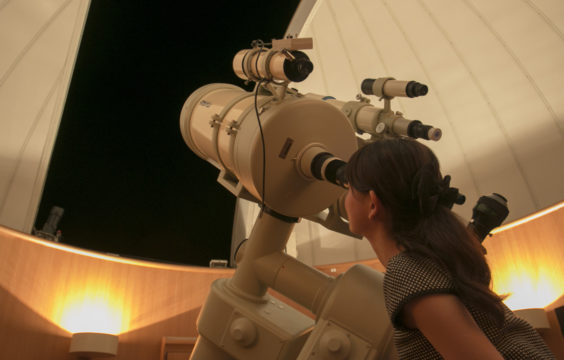
Details
- Observatory Hours… 7:30 p.m. – 10:10 p.m.
- Closed on… Every Tuesday
- Location… Otani Sanso Roof (Just beside the gallery on the 8th floor)
- Price… Free for overnight guests (Viewings available to those who reserve first)
- Using the Observatory… Viewings are available to those who reserve first (12 seats per viewing)
Observation Times
- 7:30 p.m., 7:50 p.m.
- 8:10 p.m., 8:30 p.m., 8:50 p.m.
- 9:10 p.m., 9:30 p.m., 9:50 p.m.
How to Make a Reservation
Please inform us of your desired reservation time from the times listed above (Please tell us via telephone, or write it in the “requests” field) *You may not be able to participate in a viewing if a time slot is fully booked, or due to weather conditions. *Should you be unable to participate in a viewing due to weather conditions, you will be able to see a video from a past viewing.See information from the astronomical observatory dome
■Frequently Asked Questions "Why is there an astronomical observatory on the roof of Otani Sanso?" The president of Otani Sanso, a great fan of the poems of Nagato/Senzaki-born Kaneko Misuzu, built the observatory out of a desire to "share the beautiful stars of Nagato with our guests, too." In fact, it was through a chance meeting via the Kaneko Misuzu Exchange Association that the president met with Dr. Haoru Saji, who greatly affected the president with the beauty of the stars he could see from the observatory at Tamagawa University even during the daytime. "There's much more than your eyes can see," Dr. Saji told him. "Let's take a look at the daytime stars." When you look up at the starry skies of Nagato, here, surrounded by nature, we hope you'll make memories to take home with you that you can look back on fondly.
Night Sky Trivia
The Speed of Light
- Light moves at a speed of approximately 300,000 km per second (7.5 revolutions around the Earth), and can cover 9.46 trillion km in a year.
- It takes light from the sun 8 minutes and 19 seconds to reach the earth.
- It takes 8 minutes and 19 seconds for light from the sun to reach the Earth.
Distances in Space
- Because space is so vast, we use “light years” and “astronomical units (AU)” to describe the distances between stars.
- 1 light year = the amount of distance light can travel in one year (9.5 trillion km)
- 1 astronomical unit = the distance between the sun and the Earth (approx. 150 million km)
Earth Time
- There are 24 hours in one day, but it takes 23 hours and 56 minutes for a rotation of the earth, leaving a margin of 4 minutes.
- The reason we have “leap years” is because the Earth’s orbital period around the sun is just shy of 365 Earth days.
- 1 rotation of the Earth (23 hours 56 minutes) = 400 m/sec
- 1 revolution of the Earth (365 days) = 30 km/sec
If you’d like to see more information about the night skies, the National Astronomical Observatory of Japan is extremely interesting. Please take a look.
